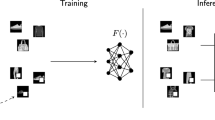Abstract
Modern face recognition systems are mostly based on deep learning models. These models need a large amount of data and high computational power to be trained. Often, a feature extraction network is pretrained on large datasets, and a classifier is finetuned on a smaller private dataset to recognise the identities from the features. Unfortunately deep learning models are exposed to malicious attacks both during training and inference phases. In backdoor attacks, the dataset used for training is poisoned by the attacker. A network trained with the poisoned dataset performs normally with generic data, but misbehave with some specific trigger data. These attacks are particularly difficult to detect, since the misbehaviour occurs only with the trigger images. In these paper we present a novel marker-free backdoor attack for face recognition systems. We generate a label-consistent poisoned dataset, where the poisoned images matches their labels and are difficult to spot by a quick visual inspection. The poisoned dataset is used to attack an Inception Resnet v1. We show that the network finetuned on the poisoned dataset is successfully fooled, identifying one of the author as a specific target identity.
The work in this paper was founded by the project PON AIM1893589 promoting the attraction of researchers back to Italy.
Access this chapter
Tax calculation will be finalised at checkout
Purchases are for personal use only
Similar content being viewed by others
References
Balakrishnan, G., Xiong, Y., Xia, W., Perona, P.: Towards causal benchmarking of bias in face analysis algorithms. In: Vedaldi, A., Bischof, H., Brox, T., Frahm, J.-M. (eds.) ECCV 2020. LNCS, vol. 12363, pp. 547–563. Springer, Cham (2020). https://doi.org/10.1007/978-3-030-58523-5_32
Cao, Q., Shen, L., Xie, W., Parkhi, O.M., Zisserman, A.: VGGFace2: a dataset for recognising faces across pose and age. In: International Conference on Automatic Face and Gesture Recognition (2018)
Deb, D., Zhang, J., Jain, A.K.: ADVFaces: adversarial face synthesis. In: 2020 IEEE International Joint Conference on Biometrics (IJCB), pp. 1–10. IEEE (2019)
Giudice, O., Guarnera, L., Battiato, S.: Fighting deepfakes by detecting GAN DCT anomalies. J. Imaging 7(8), 128 (2021). https://doi.org/10.3390/jimaging7080128
Gong, Z., Wang, W., Ku, W.S.: Adversarial and clean data are not twins. arXiv preprint arXiv:1704.04960 (2017)
Goodfellow, I., Shlens, J., Szegedy, C.: Explaining and harnessing adversarial examples. In: 3rd International Conference on Learning Representations, ICLR 2015 - Conference Track Proceedings (2015)
Li, Y., Wu, B., Jiang, Y., Li, Z., Xia, S.T.: Backdoor learning: a survey. arXiv preprint arXiv:2007.08745 (2020)
Liu, W., Wen, Y., Yu, Z., Li, M., Raj, B., Song, L.: SphereFace: deep hypersphere embedding for face recognition. In: Proceedings of the IEEE Conference on Computer Vision and Pattern Recognition, pp. 212–220 (2017)
Madry, A., Makelov, A., Schmidt, L., Tsipras, D., Vladu, A.: Towards deep learning models resistant to adversarial attacks. In: International Conference on Learning Representations (2018)
Massoli, F.V., Carrara, F., Amato, G., Falchi, F.: Detection of face recognition adversarial attacks. Comput. Vis. Image Underst. 202, 103103 (2021)
Papernot, N., McDaniel, P.: Deep k-nearest neighbors: towards confident, interpretable and robust deep learning. arXiv preprint arXiv:1803.04765 (2018)
Parkhi, O.M., Vedaldi, A., Zisserman, A.: Deep face recognition. In: Proceedings of the British Machine Vision Conference (BMVC), pp. 41.1–41.12, September 2015. https://doi.org/10.5244/C.29.41
Saha, A., Subramanya, A., Pirsiavash, H.: Hidden trigger backdoor attacks. In: Proceedings of the AAAI Conference on Artificial Intelligence, vol. 34, pp. 11957–11965 (2020)
Schroff, F., Kalenichenko, D., Philbin, J.: FaceNet: a unified embedding for face recognition and clustering. In: Proceedings of the IEEE Conference on Computer Vision and Pattern Recognition, pp. 815–823 (2015)
Taigman, Y., Yang, M., Ranzato, M., Wolf, L.: DeepFace: closing the gap to human-level performance in face verification. In: Proceedings of the IEEE Conference on Computer Vision and Pattern Recognition, pp. 1701–1708 (2014)
Tinsley, P., Czajka, A., Flynn, P.: This face does not exist... but it might be yours! identity leakage in generative models. In: Proceedings of the IEEE/CVF Winter Conference on Applications of Computer Vision, pp. 1320–1328 (2020)
Turner, A., Tsipras, D., Madry, A.: Label-consistent backdoor attacks. arXiv preprint arXiv:1912.02771 (2019)
Wang, B., et al.: Neural cleanse: identifying and mitigating backdoor attacks in neural networks. In: 2019 IEEE Symposium on Security and Privacy (SP), pp. 707–723 (2019). https://doi.org/10.1109/SP.2019.00031
Zhang, B., Tondi, B., Barni, M.: Adversarial examples for replay attacks against CNN-based face recognition with anti-spoofing capability. Comput. Vis. Image Underst. 197–198, 102988 (2020)
Zhang, K., Zhang, Z., Li, Z., Qiao, Y.: Joint face detection and alignment using multitask cascaded convolutional networks. IEEE Signal Process. Lett. 23(10), 1499–1503 (2016)
Zhao, S., Ma, X., Zheng, X., Bailey, J., Chen, J., Jiang, Y.G.: Clean-label backdoor attacks on video recognition models. In: Proceedings of the IEEE/CVF Conference on Computer Vision and Pattern Recognition, pp. 14443–14452 (2020)
Author information
Authors and Affiliations
Corresponding author
Editor information
Editors and Affiliations
Rights and permissions
Copyright information
© 2022 The Author(s), under exclusive license to Springer Nature Switzerland AG
About this paper
Cite this paper
Cauli, N., Ortis, A., Battiato, S. (2022). Fooling a Face Recognition System with a Marker-Free Label-Consistent Backdoor Attack. In: Sclaroff, S., Distante, C., Leo, M., Farinella, G.M., Tombari, F. (eds) Image Analysis and Processing – ICIAP 2022. ICIAP 2022. Lecture Notes in Computer Science, vol 13232. Springer, Cham. https://doi.org/10.1007/978-3-031-06430-2_15
Download citation
DOI: https://doi.org/10.1007/978-3-031-06430-2_15
Published:
Publisher Name: Springer, Cham
Print ISBN: 978-3-031-06429-6
Online ISBN: 978-3-031-06430-2
eBook Packages: Computer ScienceComputer Science (R0)




